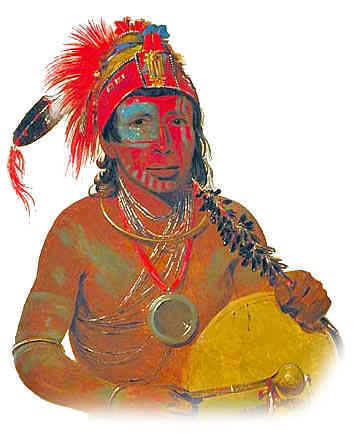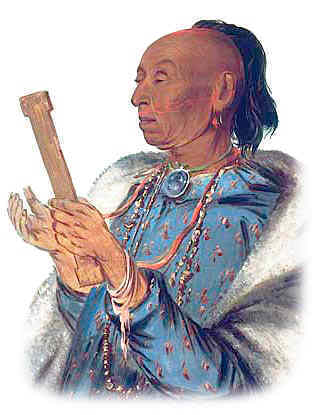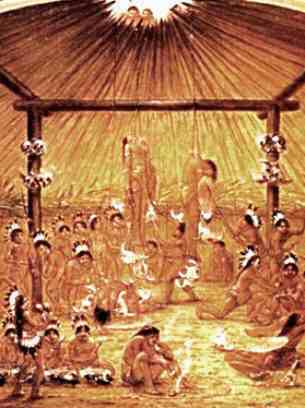The Shaman and Spirits
The belief in spirits and the ability of the Shaman to communicate with spirits was fundamental to Shamanism. The fundamental doctrine is based on the belief that every object in nature is controlled by its own independent spirit, or soul. Spirits inhabit the rivers, lakes, mountains, forests, trees, plants, sky, stars, sun, moon, animals, insects, fish, flowers and birds. Some spirits are good and help men who please them whereas other spirits are bad and liable to wreck havoc and harm on people and on tribes. It is the bad spirits that cause trouble, suffering, sickness, death and disease. If a Shaman had control over the spirits he became extremely powerful.
Medicine, Mystery and the Shaman
The healing role of the Shaman was critical. Many Native American Tribes believe that when a man is ill a bad spirit has taken away his soul or has entered into him. It is therefore not surprising that the Native Americans would wish to gain power over these spirits. The man with knowledge of spirits and the supernatural was the Shaman. A Shaman would know protective words and chants and have knowledge of objects which, if carried, would disarm bad spirits and protect their owners. Such knowledge is what the Native Indians mean by “medicine” or “mystery.” The Native Americans who spent their lives in trying to gain such knowledge are referred to as medicine men, medicine people, mystery men, or Shaman.
Shaman Regalia - Masks, Rattles and Drums
A shaman was equipped with a number of objects that helped him to communicate with spirits in other worlds. They used dances, gestures and sounds as the symbolic powers of Shaman to enter the spirit world. A Shaman also wore ceremonial clothes and carried sacred objects such as rattles and drums to incarnate the spirits of nature and amplify their power. The Shaman of some tribes also used masks that were believed to hold spiritual powers and would identify them with the spirits in other worlds and activate their powers.
Shaman Pictures
The picture of the Dakota Sioux Shaman was painted by George Catlin (1796-1872) described this Indian as a noted doctor or medicine man: “...with his medicine or mystery drum and rattle in his hands, his looking-glass on his breast, his rattle of antelope's hoofs, and drum of deer-skins.” The Picture of the Kickapoo Shaman is holding a prayer stick and was described as “a Kickapoo of some distinction, and a disciple of the Prophet; in the attitude of prayer also, which he is reading off from characters cut upon a stick that he holds in his hands.”
 |  |
| Dakota Sioux Shaman or Medicine Man | Kickapoo Shaman |
The amazing picture at the top of the page illustrates a Shaman of the Blackfoot tribe taking on the animal form of a bear. Many Native American cultures feature skin-walkers, or a similar concept, in which a shaman or Medicine Man may, according to cultural tradition, take on an animal form such as a bear.
The Shaman, Ceremonies and Secret Societies
Among some tribes, notably amongst the Southwest Indians there are secret societies which practise spirit wisdom for the benefit of the individual, or for the good of the whole tribe. The Shaman secret societies may work to cure disease in individuals or work for the whole tribe to combat adversities. There were secret medicine societies of the Seneca, and of many other Native American tribes. Each Medicine Society is dedicated to the Medicine of a particular earth spirit, such as the Wolf or the Bear. Among the Moki Pueblos, the societies of the Snake and of the Antelope carry on the Snake Dance which is ceremoniously performed so that the tribe may have rain for their fields. The Okipa is a sacred Sun ceremony of Plains People during which the Shaman would prepare the lodge and the participants for the ceremony which involved elements of fasting, torture and a vision quest or a plea or prayer to the spirits.

Okipa Sun Ceremony
For additional Information on Shaman refer to the article on the Shaman Symbol.
Shaman
- Native American Shaman
- Shaman and the beliefs of Animists
- The Culture of Shaman
- Words and terminology associated with Shaman
- Meanings of Fetishes & Shaman
- Native American Indian Shaman, culture and religious beliefs
Pictures and Videos of Native Americans
Shaman. Discover the vast selection of pictures which relate to the History of Native Americans and illustrate many decorations and tattoos used by American Indians. The pictures show the clothing, tattoos, war paint, weapons and decorations of various Native Indian tribes that can be used as a really useful educational history resource for kids and children of all ages and a means to study their interpretation. We have included pictures to accompany the main topic of this section - Shaman and Native American Culture. The videos enable fast access to the images, paintings and pictures together with information and many historical facts.